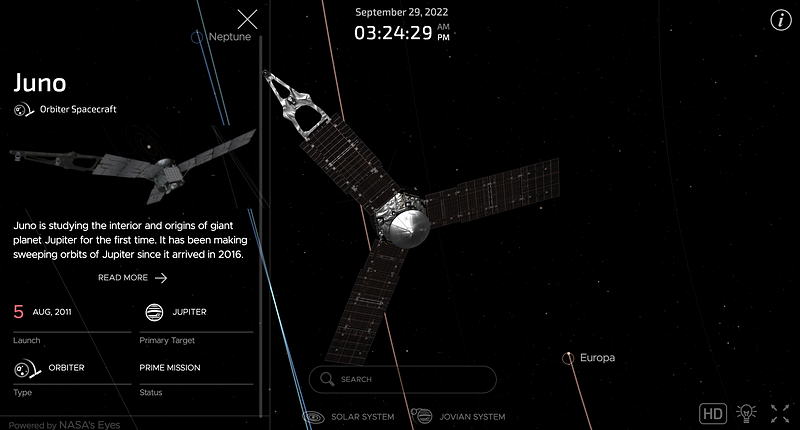Exploring Europa: Juno's Groundbreaking Flyby of Jupiter's Moon
Written on
Chapter 1: The Juno Probe's Close Encounter with Europa
NASA's Juno spacecraft has recently completed its closest approach to Europa, Jupiter's icy moon, marking the first detailed imaging of its surface in over two decades. The last mission to achieve this was the Galileo probe in 2000. While the new images highlight Europa's frozen exterior, researchers are particularly fascinated by the mysteries hidden beneath this icy shell.

[Photo: TheLostProbe (Screenshot), Askaniy Anpilogov + FarGetaNik/JaguarJack/Panterstruck (Textures), CC BY-SA 4.0, via Wikimedia Commons]
Insights from previous missions, including the Voyager spacecraft's flyby of the Jupiter system in 1979 and Galileo’s orbital observations from 1995 to 2003, reveal that beneath Europa's thick icy crust lies a vast ocean of salty water, estimated to be about 90 kilometers deep. This ocean remains liquid due to the intense tidal forces exerted by Jupiter, which deform Europa's surface and generate heat. Some of this heat may also result from the decay of radioactive isotopes, possibly leading to hydrothermal vents on the ocean floor. Such environments are thought to be where life on Earth first emerged, as they provide essential nutrients and energy for simple organisms.
Section 1.1: New Images from Juno
The latest imagery from the Juno spacecraft includes stunning views of the Annwn Regio region, situated near Europa's equator. Captured from just 352 kilometers above the surface, these images reveal extensive cracks that traverse the moon’s bright, icy exterior. Researchers believe that these fissures may further confirm the presence of an underlying ocean. The photos also showcase the interplay of light and shadow along the terminator line, highlighting the terrain's irregularities.

[Photo credit: NASA/JPL-Caltech/SWRI/MSSS, Public domain]
Subsection 1.1.1: Anticipating More Data from Juno
Since its launch in 2016, the Juno probe has been on a mission to study Jupiter and its moons. During its brief two-hour window to collect data on Europa, Juno sped through the region at an impressive 23.6 kilometers per second (nearly 85,000 km/hr). Despite the rapid pace, the JunoCam was able to capture high-resolution images of Europa's surface at a rate of one kilometer per pixel.
“All signs point to Juno's flyby of Europa being a tremendous success,” stated Scott Bolton, the principal investigator for Juno at the Southwest Research Institute in San Antonio. “The initial image is just a glimpse of the wealth of knowledge we will acquire from Juno's array of instruments and sensors. We have gathered critical data regarding Europa’s ice crust, internal structure, surface composition, and interactions with Jupiter's magnetosphere,” he added.

[Photo credit: NASA/JPL-Caltech, Public domain]
Chapter 2: The Future of Europa Exploration
In addition to Juno's findings, the Europa Clipper mission is set to launch in two years, with the goal of reaching Europa by 2030. This upcoming probe aims to explore the moon's icy crust and the liquid water beneath, examining their interactions to determine the potential for life. The mission will include efforts to create a detailed geological map of Europa and analyze its surface composition. Instruments onboard will also investigate Europa's thin atmosphere and any particles ejected by geysers, as well as its magnetic field. A key objective is to identify a suitable landing site for future exploration.
The video titled "Jupiter's icy moon Europa seen up close by NASA's Juno spacecraft" offers an overview of the latest findings and imagery from the Juno mission.
In the video "NASA Science Live: Juno Spacecraft Makes Historic Flybys of Jupiter's Moons," viewers can gain insights into the significance of Juno's flybys and what they mean for our understanding of Europa.
A remarkable discovery in the Galilee. Mosaics and traces of an ancient settlement found!
Archaeologists say that a settlement in Galilee in the past was probably inhabited by Christians or Jews. Why didn’t…
Cool that you made it to the end of this article. I will be very pleased if you appreciate the effort of creating it and leave some claps here, or maybe even start following me. It would be nice if you also left a tip! Thank you!